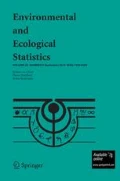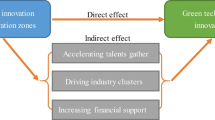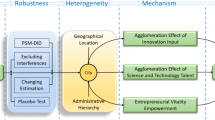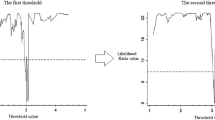Abstract
This paper measured the efficiency of green science and technology (S&T) innovation in 30 Chinese provinces from 2008 to 2017 by constructing a three-stage super-efficiency DEA model that contains undesired output and then analyzed the spatial performance for these provinces. The purpose is to calculate exactly the extent to which S&T innovation in different regions of China has contributed to economic development, excluding negative impacts on the ecological environment and any spatial differences that have emerged in the past decade. The results show that the overall performance of green S&T innovation efficiency in Chinese regions was poor in the past decade, and there is still much room for improvement. In addition, China's investment in S&T innovation and environmental management is inefficient and wasteful. From the temporal perspective, efficiency in green innovation shows a slowly increasing trend. From the spatial perspective, the efficiency shows a strict correlation with economic development, that is, an obvious three-level spatial distribution pattern of "east, middle, and west".


Similar content being viewed by others
References
Andersen P, Petersen NC (1993) A procedure for ranking efficient units in data envelopment analysis. Manage Sci 39:1261–1264
Cao X, Yu J (2015) Regional innovation efficiency in China from the green low-carbon perspective, China population. Resour Environ 25:10–19
Charnes A, Cooper WW, Rhodes E (1978) Measuring the efficiency of decision making units. Eur J Oper Res 2:429–444
European Commission (2011) Environmental Technology Action Plan (Eco AP), http://eurlex.europa.eu/LexUriServ/LexUriServ.do?uri=COM:2011:0899:FIN:EN:PDF
Fried L, Schmidt Y (2002) Accounting for environmental effects and statistical noise in data envelopment analysis. J Prod Anal 17:121–136
Gong XS, Li MJ, Zhang HZ (2017) Has OFDI promoted the industrial enterprises’ green innovation efficiency in China—evidence based on agglomeration economic effect. J Int Trade 11:127–137
Huang L, Wu CQ (2019) Research on the efficiency and synergetic effect of industry’s green development and innovative development in the Yangtze River economic belt. J Chongqing Univ (Soc Sci Ed) 3:1–13
Khan Z, Ali M, Kirikkaleli D, Wahab S, Jiao Z (2020) The impact of technological innovation and public-private partnership investment on sustainable environment in China: consumption-based carbon emissions analysis. Sustain Dev 1–14
Liu J, Song QY (2018) Space Network structure and formation mechanism of green innovation efficiency of tourism industry in China. China Popul Resour Environ 28:127–137
Li JW, Zhang XY, Ali Shahid, Khan Zeeshan (2020) Eco-innovation and energy productivity: new determinants of renewable energy consumption. J Environ Manage 271:111028
Li ZZ, Li YM, Malik MY, Murshed M, Khan Z, Umar M (2020) Determinants of carbon emission in China: how good is green investment? Sustain Prod Consump Sustain Prod Consump 27:392–401
Luo LW, Liang SR (2017) The Spatial Effect Of International R&D capital technology spillovers on the efficiency of China’s green technology innovation. Bus Manage J 39:21–33
Nie MH, Qi H (2019) Can OFDI improve China' s industrial green innovation efficiency?: based on the perspective of innovation value chain and spatial correlation effect. World Econ Stud 2:111–122+137.
Peng WB, Cheng FF, Lu JL (2017) A study on the threshold effect of environmental regulation to provincial green innovation efficiency. South China J Econ 9:73–84
Qian L, Wang WP, Xiao RQ (2018) Research on the regional disparities of China’s industrial enterprises green innovation efficiency from the perspective of shared inputs. China Popul Resour Environ 28:27–39
Rasi K, Ester MR (2016) Towards green growth: how does green innovation affect employment. Res Policy 45:1218–1232
Ren Y, Niu CH, Niu T, Yao XL (2014) Theoretical model and empirical research on green innovation efficiency. Manage World 7:176–177
Rennings K, Markewitz P, Vegele S (2016) How clean is clean incremental versus radical technological change in coal-fired power plants. J Evol Econ 2:331–355
Shen N, Zhou JJ (2018) A study on China’s green innovation efficiency evaluation and functional mechanism based on hybrid DEA and SEM model. J Ind Eng Eng Manage 32:46–53
Shen YJ, Su ZW, Malik MY, Umar M, Khan Z, Khan M (2021) Does green investment, financial development and natural resources rent limit carbon emissions? A provincial panel analysis of China. Sci Tot Environ 755:142538
Tone K (2002) A slacks–based measure of super—efficiency in data envelopment analysis. Eur J Oper Res 143:32–41
Wang H, Wang SQ, Miao Z, Li XC (2016) Heterogeneity threshold effect of R&D investment on green innovation efficiency based on chinese high–tech industries. Sci Res Manage 37:63–71
Xiao LM, Gao JF, Liu S (2017) Trend of green technology innovation efficiency in China based on spatial gradient—empirical analysis of inter-provincial panel data. Soft Sci 31:63–68
Xiao LM, Zhang XP (2019) Spatio-temporal characteristics of coupling coordination between green innovation efficiency and ecological welfare performance under the concept of strong sustainability. J Nat Resour 34:312–324
Xu JZ, Wang MM, Guan J (2019) Research on mechanism of carbon emission from energy consumption and green innovation efficiency in dynamic endogenous perspective based on chinese equipment manufacturing industries. Manage Rev 31:81–93
Yang SW, Wu T, Li ZB (2018) Spatial and temporal differentiation of green innovation efficiency in cities of Yangtze River economic belt and its influencing factors. Urban Probl 6:107–117+132
Yao XL, Niu CH, Liu J (2015) Innovation driven, green growth and industrial economic efficiency. Forum Sci Technol China 57-62
Yi M, Cheng XM (2018) Spatial and temporal differentiation of green innovation efficiency in cities of Yangtze River economic belt and its influencing factors. Urban Probl 31–39
Yu SJ, Li XS, Peng ZY (2017) Research on environmental regulation model and green innovation efficiency of Yangtze River economic belt—an empirical analysis based on 38 cities. Jianghai Acad J 209-214
Zhang JQ, Pu SD (2017) Measuring allocation efficiency of regional green S&T resource based on three-stage SBM-DEA—taking guilin city as an example. Resour Dev Market 33:1–7
Zhu CL, Liu RM, Wang HW (2018) Green innovation performance evaluation and promotion path of patent intensive industries. J Quant Techn Econ 35:61–79
Acknowledgements
This work was supported by the National Natural Science Foundation of China (Grant No. 41401634)and Social Science Research Foundation of Nanjing University of Posts and Telecommunications (Grant No. NYY220006).
Author information
Authors and Affiliations
Corresponding author
Additional information
Handling Editor: Luiz Duczmal.
Rights and permissions
About this article
Cite this article
Mingran, W. Measurement and spatial statistical analysis of green science and technology innovation efficiency among Chinese Provinces. Environ Ecol Stat 28, 423–444 (2021). https://doi.org/10.1007/s10651-021-00491-7
Received:
Revised:
Accepted:
Published:
Issue Date:
DOI: https://doi.org/10.1007/s10651-021-00491-7




